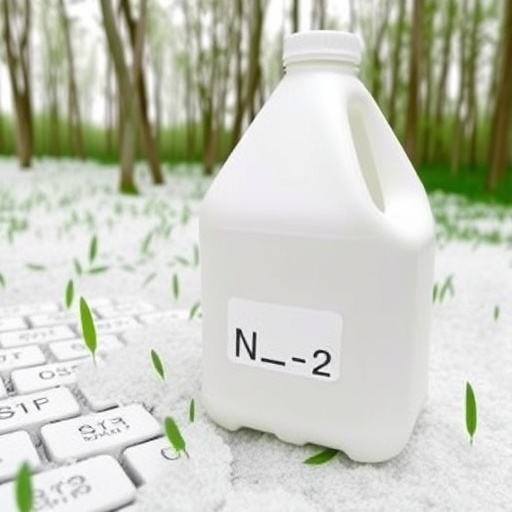The increasing challenges posed by climate change demand innovative approaches in agriculture to sustain crop productivity while minimizing adverse environmental impacts. In this context, a groundbreaking study has been conducted on the effects of liquid nano urea and coated urea fertilizers specifically under conditions of elevated carbon dioxide (CO2) and temperature interactions, which are becoming ever more prevalent due to global warming. The research, led by Apoorva M.S. and collaborators, seeks to elucidate how these advanced fertilizers can enhance agronomic efficiency while mitigating gaseous nitrogen (N) losses— a critical concern in contemporary agricultural practices.
Liquid nano urea represents a novel class of nitrogen fertilizer that offers distinct advantages over conventional urea. The primary innovation in this formulation lies in its nanoscale size, which facilitates enhanced absorption by plant roots. This increased efficiency means that less nitrogen is required to achieve optimal growth, a substantial benefit considering nitrogen runoff’s negative effects on environmental quality. As nitrate can contaminate waterways, understanding and optimizing nitrogen use efficiency is essential for sustainable agricultural practices.
On the other hand, coated urea fertilizers have been designed to slowly release nitrogen over an extended period, which decreases the volatility of nitrogen gas through processes such as nitrification and denitrification. By coupling these advanced fertilizers with elevated CO2 levels, this study aims to identify intricate interactions that could potentially promote better nutrient uptake in crops. The findings are crucial in the context of improving crop resilience against climate stressors while optimizing input use to reduce environmental impact.
The study was conducted with various cropping systems, strategically chosen to mimic real-world agricultural conditions under future climate scenarios. Elevated CO2 and temperature settings were applied to examine their effects on crop yield performance and nitrogen use efficiency. Crop responses to these changes were measured by analyzing growth parameters such as plant height, chlorophyll content, and yield ratios. The results are poised to provide essential insights into the future of sustainable agriculture and food security.
One of the standout findings of the research was how liquid nano urea increased nutrient uptake in crops more effectively than conventional fertilizers. Enhanced nutrient absorption is vital for plant health and productivity. This study’s insights could translate into significant improvements in crop yield, vital for feeding an ever-growing global population while simultaneously addressing the environmental consequences of traditional farming practices.
Moreover, coated urea demonstrated remarkable efficiency in nutrient release, aligning with plant growth stages. By releasing nitrogen gradually, coated urea reduces the chances of nitrogen leaching into ecosystems, which can lead to eutrophication—a process that depletes oxygen in water bodies, adversely affecting aquatic life. This controlled release mechanism, combined with the dual stressors of elevated CO2 and temperature, indicates a strong potential for coated urea to enhance agronomic efficiency under climate change scenarios.
The implications of such findings are profound. As farmers grapple with the dual challenges of maintaining crop productivity while being stewards of the environment, these advanced fertilizer options will offer a pathway towards achieving both goals. The research suggests that adopting liquid nano urea and coated urea can improve nitrogen management strategies, aligning agricultural practices with sustainability objectives.
Furthermore, the study called attention to the likely future of crop management systems that integrate advanced fertilizers with precision farming technologies. By leveraging data-driven decision-making tools, farmers can optimize fertilizer application timing and quantities based on real-time environmental conditions, further enhancing agricultural productivity and minimizing waste. This approach aligns with the growing movement towards regenerative agriculture, which emphasizes sustainable soil health and ecosystem stewardship.
As countries around the world face strict regulations regarding greenhouse gas emissions, improving nitrogen use efficiency while reducing gaseous N losses is increasingly critical. Thus, the findings from this study could guide agricultural policies supporting the adoption of cutting-edge technologies that drive sustainable farming practices. Policymakers must recognize such studies’ importance to translate scientific insights into actionable frameworks that support farmers in implementing these advanced agricultural techniques.
The chemical mechanisms underlying the interaction between various nitrogen fertilizers and plant systems must also be further explored. Greater understanding in this area could facilitate the development of future fertilizers that not only meet current agricultural needs but also possess enhanced environmental benefits. As agronomists continue to innovate, studies like this provide essential blueprints for integrating science and agriculture to foster resilient farming systems.
This research lays the groundwork for crucial discussions on the future trajectories of fertilizer technologies in light of climate change. Given the urgent need for solutions that not only enhance agricultural productivity but also safeguard the environment, the implications of utilizing liquid nano urea and coated urea in farming systems could transcend national boundaries, influencing global agricultural practices and policies.
In conclusion, this groundbreaking study highlights the potential of advanced fertilizer technologies in the face of climate change. The enhanced agronomic efficiency demonstrated by liquid nano urea and coated urea offers promising avenues for mitigating environmental impact while meeting the food demands of the global population. As the agricultural community navigates these challenges, embracing innovation will be pivotal in shaping a sustainable future for farming worldwide.
Subject of Research: The effects of liquid nano urea and coated urea on gaseous nitrogen losses and agronomic efficiency under elevated CO2 and temperature interactions.
Article Title: Effect of liquid nano urea and coated urea on gaseous N losses and agronomic efficiency under elevated CO2 and temperature interaction.
Article References:
Apoorva, M.S., Bhatia, A., Chakrabarti, B. et al. Effect of liquid nano urea and coated urea on gaseous N losses and agronomic efficiency under elevated CO2 and temperature interaction. Environ Sci Pollut Res (2025). https://doi.org/10.1007/s11356-025-36986-0
Image Credits: AI Generated
DOI: https://doi.org/10.1007/s11356-025-36986-0
Keywords: liquid nano urea, coated urea, nitrogen loss, agronomic efficiency, climate change, sustainable agriculture.




